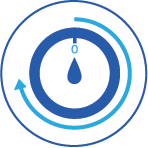How does Xcel Energy net metering work?
Xcel Energy's net metering program allows customers to get credit back from excess generation on a bill when the amount of energy a solar panel system generates is greater than the amount of energy consumed from Xcel Energy. Customers receive payment for the excess energy generated.
Where does Xcel Energy offer net metering?
Xcel Energy has customers in eight states: Colorado, Michigan, Minnesota, New Mexico, North Dakota, South Dakota, Texas, and Wisconsin. The utility offers net metering in seven of those states (all except South Dakota).
-
- State
- Colorado
- Program available?
- Yes
- Program website
- Website
-
- State
- Michigan
- Program available?
- Yes
- Program website
- Website
-
- State
- Minnesota
- Program available?
- Yes
- Program website
- Website
-
- State
- New Mexico
- Program available?
- Yes
- Program website
- Website
-
- State
- North Dakota
- Program available?
- Yes
- Program website
- Website
-
- State
- South Dakota
- Program available?
- No
- Program website
- (none)
-
- State
- Texas
- Program available?
- Yes
- Program website
- Website
-
- State
- Wisconsin
- Program available?
- Yes
- Program website
- Website
What are Xcel Energy's rates and prices for net metering?
The size of a solar panel system allowed on a customer's residence is determined by the customer’s total electricity usage from the previous year. The total output of the system must not be greater than 120% of the energy used by the customer. For most homeowners, this means that their solar panel systems are Level 1 and generate 10 kilowatts (kW) or less.
Net metering credits can be applied to a customer's account in one of two ways. Customers can choose to receive kilowatt-hour (kWh) based credits which are applied to future bills to offset customer energy consumption. They can also choose to receive a per-kWh cash payment determined by the Average Hourly Incremental Cost of Electricity from the previous year. This rate is an average calculated from the last 50 megawatts (MW) of energy that includes the cost of fuel and transaction costs in the total price.
What is Xcel Energy's net metering cap?
Net metering caps are set at the state level. As a result, Xcel Energy’s net metering cap varies by state.
-
- State
- Colorado
- Cap (%)
- None
- Cap (MW)
- None
-
- State
- Michigan
- Cap (%)
- 0.75% of annual peak load
- Cap (MW)
- 1.95 MW (2015)
-
- State
- Minnesota
- Cap (%)
- 4% of annual retail electric sales
(not a firm cap) - Cap (MW)
- None
-
- State
- New Mexico
- Cap (%)
- None
- Cap (MW)
- None
-
- State
- North Dakota
- Cap (%)
- None (No state net metering policy)
- Cap (MW)
- None (No state net metering
policy)
-
- State
- South Dakota
- Cap (%)
- None
- Cap (MW)
- None
-
- State
- Texas
- Cap (%)
- None
- Cap (MW)
- None
-
- State
- Wisconsin
- Cap (%)
- None (No state net metering policy)
- Cap (MW)
- None (No state net metering
policy)
Is Xcel Energy's net metering the best in Colorado, Michigan, Minnesota, New Mexico, North Dakota, South Dakota, Texas, or Wisconsin?
Colorado
Xcel Energy and Black Hills Energy are the two investor-owned utilities available in Colorado; both offer net metering. In addition, there are 29 municipal utilities and 22 rural electric cooperatives which aren’t required to offer net metering. Xcel Energy offers one of the best net metering options in Colorado – the utility is committed to promoting renewable energy, and its net metering program as a whole appears to generate more applications and usage.
Michigan
Xcel Energy's presence in Michigan is small. For those customers who live in Xcel Energy’s Michigan territory, its net metering program is a good choice; however, it is not accessible to the majority of Michigan residents.
Minnesota
Xcel Energy offers strong solar incentives to its customers in Minnesota. In addition to net metering, the utility offers per-kWh cash incentives through its Solar*Rewards program. For those who can’t install solar, its Solar*Rewards*Community program allows customers to invest in community solar garden projects within the Xcel Energy system which generates local solar energy for participating customers.
Minnesota Power is another electric utility in the state with a commitment to using renewable resources – the utility is committed to providing 44 percent of the company's energy supply by 2025. However, this utility only serves northeastern Minnesota and does not have coverage area in the Twin Cities metro area making Xcel the more accessible choice for many Minnesotans.
New Mexico
Xcel Energy offers an incentive program in New Mexico called the Solar*Rewards program, which offers per-kWh cash incentives for customers to install rooftop solar. Other electric utilities in New Mexico also offer solar incentive programs such as the state's largest provider, PNM, and El Paso Electric serving southern New Mexico. Xcel Energy's program is comparable to other utilities and for customers in New Mexico – choosing a company comes down to location.
North Dakota
Xcel Energy's presence in North Dakota is small serving less than 89,000 customers meaning that for those customers with access, Xcel is a good choice but is not accessible to the majority of North Dakota residents.
South Dakota
Xcel Energy's presence in South Dakota is small (serving less than 85,000 customers), but includes cities such as Sioux Falls. For those customers with access, Xcel is a good choice but is not available to the majority of South Dakota residents.
Texas
Xcel Energy has a presence in northern Texas and offers net metering to customers in that area. Texas does not require utilities to offer net metering, which means that customers of many other utilities don’t have net metering available to them. For utility customers that live in Xcel’s service territory, Xcel’s net metering program is the best option.
Wisconsin
Xcel Energy is a strong solar option for eligible customers in Wisconsin. For those who can’t install solar, its Solar*Rewards*Community program allows customers to invest in community solar garden projects within the Xcel Energy system which generates local solar energy for participating customers. Other electric utilities in the state include Alliant Energy which offers a similar net metering program but does not have a community solar program.
What will happen to my Xcel Energy net metering bill credits?
Xcel Energy has slightly different policies for excess net metering bill credits in each state that it operates. However, they all function with the same basic principle.
When a customer generates more electricity than they used in a month, Xcel Energy considers that customer a “net producer” and does not bill the customer for any kilowatt hours (kWh) during that billing cycle. The net producer receives bill credits for each excess kWh produced and these credits are stored in a “Solar Bank” for future use.
Michigan, North Dakota, South Dakota, Texas, Colorado, and Wisconsin
There are two ways to use the Solar Bank. Continuous Rollover Credits offset bills in months when customer consumption exceeds solar panel system generation. These credits never expire but cannot be cashed out or given as credit if the service is stopped. Customers also have the option to “Waive Your Decision,” at which point they receive a year-end payout for any excess generation credits. These credits are valued at the Average Hourly Incremental Cost of Energy from the previous 12 months, which is calculated based on the cost the utility incurred by generating and producing electricity.
Minnesota
In Minnesota, customer bill credits are rolled over monthly until the customer reaches a bill credit amount of $25 or more. When this amount is reached, Xcel Energy sends customers a check for the total amount.
New Mexico
In New Mexico, customer bill credits roll over monthly until the customer reaches or exceeds a bill credit amount of $50. When this amount is reached, Xcel Energy sends customers a check for the total amount.
Does Xcel Energy offer other solar incentives?
Xcel Energy offers financial incentive programs in Colorado, Minnesota, New Mexico, and Wisconsin. The Solar*Rewards program offers per-kWh cash incentives for customers to install rooftop solar in Colorado, Minnesota, and New Mexico. In addition, the Solar*Rewards*Community program in Colorado and Minnesota allows customers to purchase electricity by investing in community solar garden projects within the Xcel Energy system; the Solar*Connect Community program in Wisconsin has a similar offering.
Xcel Energy solar interconnection policies and costs
The interconnection process for connecting a solar panel system is usually left to the solar installer who will submit the interconnection application on the customer's behalf. For customers who want to register their own application, they will need to log into the Solar Application Portal on the Xcel Energy website and complete the application online.
Along with the application, the customer or solar installer must also submit an application deposit which will be refunded if the application is completed within 12 months. There is also an Interconnection Study Fee for all Solar*Rewards applicants, which is $100 for Level 1 systems (below 10kW and most residential systems), $1,000 for Level 2 systems (10-250kW), and $2,000 for systems between 250kW-2MW.
-
- Customer type
- Level 1
- System size
- ≤10kW
- Interconnection fee
- $100
-
- Customer type
- Level 2
- System size
- 10kW - 250kW
- Interconnection fee
- $1,000
-
- Customer type
- Level 2*
- System size
- 250kW - 2MW
- Interconnection fee
- $2,000
Colorado
The application in Colorado also requires installers to be qualified under the North American Board of Certified Energy Practitioners (NABCEP) for solar panel systems to receive incentives. Xcel Energy must collect and maintain this documentation via the Photovoltaic Installation Supervision Certification form which is available online.
Looking for the best solar companies in Xcel Energy territory?
You wouldn’t buy a car without comparing a few options first.Shouldn’t solar be the same?
Compare multiple solar quotes on EnergySage
With EnergySage, you can compare your solar options when you
receive quotes from the best local solar installers near you.
Get a quick estimate of your savings with solar
Find out how affordable solar is for your home with our Solar Calculator, or simply register your property today to get quotes.






